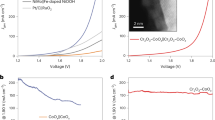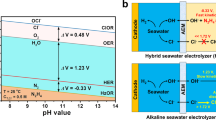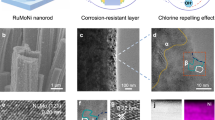Abstract
Electrochemical saline water electrolysis using renewable energy as input is a highly desirable and sustainable method for the mass production of green hydrogen1,2,3,4,5,6,7; however, its practical viability is seriously challenged by insufficient durability because of the electrode side reactions and corrosion issues arising from the complex components of seawater. Although catalyst engineering using polyanion coatings to suppress corrosion by chloride ions or creating highly selective electrocatalysts has been extensively exploited with modest success, it is still far from satisfactory for practical applications8,9,10,11,12,13,14. Indirect seawater splitting by using a pre-desalination process can avoid side-reaction and corrosion problems15,16,17,18,19,20,21, but it requires additional energy input, making it economically less attractive. In addition, the independent bulky desalination system makes seawater electrolysis systems less flexible in terms of size. Here we propose a direct seawater electrolysis method for hydrogen production that radically addresses the side-reaction and corrosion problems. A demonstration system was stably operated at a current density of 250 milliamperes per square centimetre for over 3,200 hours under practical application conditions without failure. This strategy realizes efficient, size-flexible and scalable direct seawater electrolysis in a way similar to freshwater splitting without a notable increase in operation cost, and has high potential for practical application. Importantly, this configuration and mechanism promises further applications in simultaneous water-based effluent treatment and resource recovery and hydrogen generation in one step.
This is a preview of subscription content, access via your institution
Access options
Access Nature and 54 other Nature Portfolio journals
Get Nature+, our best-value online-access subscription
$29.99 / 30 days
cancel any time
Subscribe to this journal
Receive 51 print issues and online access
$199.00 per year
only $3.90 per issue
Buy this article
- Purchase on Springer Link
- Instant access to full article PDF
Prices may be subject to local taxes which are calculated during checkout



Similar content being viewed by others
Data availability
The data that support the findings of this study are available from the corresponding authors upon reasonable request.
References
Nishiyama, H. et al. Photocatalytic solar hydrogen production from water on a 100-m2 scale. Nature 598, 304–307 (2021).
Dresp, S., Dionigi, F., Klingenhof, M. & Strasser, P. Direct electrolytic splitting of seawater-opportunities and challenges. ACS Energy Lett. 4, 933–942 (2019).
Jin, H., Wang, X., Tang, C., Vasileff, A. & Qiao, S. Stable and highly efficient hydrogen evolution from seawater enabled by an unsaturated nickel surface nitride. Adv. Mater. 33, 2007508 (2021).
Karunadasa, H. I. et al. A molecular MoS2 edge site mimic for catalytic hydrogen generation. Science 335, 698–702 (2012).
Shi, L. et al. Using reverse osmosis membranes to control ion transport during water electrolysis. Energy Environ. Sci. 13, 3138–3148 (2020).
Veroneau, S. S. & Nocera, D. G. Continuous electrochemical water splitting from natural water sources via forward osmosis. Proc. Natl Acad. Sci. USA 118, e2024855118 (2021).
Veroneau, S. S., Hartnett, A. C., Thorarinsdottir, A. E. & Nocera, D. G. Direct seawater splitting by forward osmosis coupled to water electrolysis. ACS Appl. Energy Mater. 5, 1403–1408 (2022).
Kuang, Y. et al. Solar-driven, highly sustained splitting of seawater into hydrogen and oxygen fuels. Proc. Natl Acad. Sci. USA 116, 201900556 (2019).
Sun, F., Qin, J. & Wang, Z. Energy-saving hydrogen production by chlorine-free hybrid seawater splitting coupling hydrazine degradation. Nat. Commun. 12, 4182 (2021).
Dresp, S., Thanh, T. N., Klingenhof, M., Brueckner, S. & Strasser, P. Efficient direct seawater electrolysers using selective alkaline NiFe-LDH as OER catalyst in asymmetric electrolyte feeds. Energy Environ. Sci. 13, 1725–1729 (2020).
Yu, L., Zhu, Q., Song, S., Mcelhenny, B. & Ren, Z. Non-noble metal-nitride based electrocatalysts for high-performance alkaline seawater electrolysis. Nat. Commun. 10, 5106 (2019).
Miao, J., Xiao, F. X., Yang, H. B., Khoo, S. Y. & Liu, B. Hierarchical Ni–Mo–S nanosheets on carbon fiber cloth: a flexible electrode for efficient hydrogen generation in neutral electrolyte. Sci. Adv. 1, 1500259 (2015).
Dinh, C. T. et al. Multi-site electrocatalysts for hydrogen evolution in neutral media by destabilization of water molecules. Nat. Energy 4, 107–114 (2019).
Tong, W. et al. Electrolysis of low-grade and saline surface water. Nat. Energy 5, 367–377 (2020).
Loutatidou, et al. Capital cost estimation of RO plants: GCC countries versus southern Europe. Desalination 347, 103–111 (2014).
Caldera, U. & Breyer, C. Learning curve for seawater reverse osmosis desalination plants: capital cost trend of the past, present and future. Water Resour. Res. 53, 10523–10538 (2017).
Choudhury, M. R., Anwar, N., Jassby, D. & Rahaman, M. S. Fouling and wetting in the membrane distillation driven wastewater reclamation process—a review. Adv. Colloid Interface Sci. 269, 370–399 (2019).
Ahmad, N. A., Goh, P. S., Yogarathinam, L. T., Zulhairun, A. K. & Ismail, A. F. Current advances in membrane technologies for produced water desalination. Desalination 493, 114643 (2020).
Generous, M. M., Qasem, N., Akbar, U. A. & Zubair, S. M. Techno-economic assessment of electrodialysis and reverse osmosis desalination plants. Sep. Purif. Technol. 272, 118875 (2021).
Wang, M. et al. Ultrafast seawater desalination with covalent organic framework membranes. Nat. Sustain. 5, 518–526 (2022).
Jones, E., Qadir, M., van Vliet, M. T., Smakhtin, V. & Kang, S.-M. The state of desalination and brine production: a global outlook. Sci. Total. Environ. 657, 1343–1356 (2019).
Ursua, A., Gandia, L. M. & Sanchis, P. Hydrogen production from water electrolysis: current status and future trends. Proc. IEEE 100, 410–426 (2012).
Yin, Y., Jeong, N. & Tong, T. The effects of membrane surface wettability on pore wetting and scaling reversibility associated with mineral scaling in membrane distillation. J. Membr. Sci. 614, 118503 (2020).
Qiu, H. et al. Functional polymer materials for modern marine biofouling control. Prog. Polym. Sci. 127, 101516 (2022).
Yang, K. et al. A roadmap to sorption-based atmospheric water harvesting: from molecular sorption mechanism to sorbent design and system optimization. Environ. Sci. Technol. 55, 6542–6560 (2021).
Tereshchenko, & Anatoly, G. Deliquescence: hygroscopicity of water‐soluble crystalline solids. J. Pharm. Sci. 104, 3639–3652 (2015).
Lan, C., Xie, H., Wu, Y., Chen, B. & Liu, T. Nanoengineered, Mo-doped, Ni3S2 electrocatalyst with increased Ni–S coordination for oxygen evolution in alkaline seawater. Energy Fuels 36, 2910–2917 (2022).
Hausmann, J. N., Schlögl, R., Menezes, P. & Driess, M. Is direct seawater splitting economically meaningful? Energy Environ. Sci. 14, 3679–3685 (2021).
Qtaishat, M., Matsuura, T., Kruczek, B. & Khayet, M. Heat and mass transfer analysis in direct contact membrane distillation. Desalination 219, 272–292 (2008).
Matsuura, T. Synthetic Membranes and Membrane Separation Processes (CRC, 2020).
Iversen, S. B., Bhatia, V. K., Dam-Johansen, K. & Jonsson, G. Characterization of microporous membranes for use in membrane contactors. J. Membr. Sci. 130, 205–217 (1997).
Khalifa, A., Ahmad, H., Antar, M., Laoui, T. & Khayet, M. Experimental and theoretical investigations on water desalination using direct contact membrane distillation. Desalination 404, 22–34 (2017).
Phattaranawik, J., Jiraratananon, R. & Fane, A. G. Effect of pore size distribution and air flux on mass transport in direct contact membrane distillation. J. Membr. Sci. 215, 75–85 (2003).
Khayet, M., Velázquez, A. & Mengual, J. I. Modelling mass transport through a porous partition: effect of pore size distribution. J. Non Equilibrium Thermodyn. 29, 279–299 (2004).
Lawson, K. W. & Lloyd, D. R. Membrane distillation. J. Membr. Sci. 124, 1–25 (1997).
Balej, J. Water vapour partial pressures and water activities in potassium and sodium hydroxide solutions over wide concentration and temperature ranges. Int. J. Hydrogen Energy 10, 233–243 (1985).
Chu, P. C., Fan, C. & Liu, W. T. Determination of vertical thermal structure from sea surface temperature. J. Atmos. Ocean. Technol. 17, 971–979 (2000).
Levitus, S. & Boyer, T. P. World Ocean Atlas 1994. Volume 4. Temperature (National Environmental Satellite, Data, and Information Service, 1994).
Straub, A. P., Yip, N. Y., Lin, S., Lee, J. & Elimelech, M. Harvesting low-grade heat energy using thermo-osmotic vapour transport through nanoporous membranes. Nat. Energy 1, 16090 (2016).
Acknowledgements
This work is supported by the National Natural Science Foundation of China (grant numbers 52004166, 52104400 and 51827901) and the Science and Technology Department of Sichuan Province (grant number 2020YFH0012). We thank the Program for Guangdong Introducing Innovative and Entrepreneurial Teams (grant number 2019ZT08G315), and we thank the Institute of New Energy and Low-Carbon Technology, Sichuan University for support.
Author information
Authors and Affiliations
Contributions
H.X., T.L. and Z.S. conceived and designed the project. Z.Z., Y.W. and C.L. performed the characterizations and experiments. Z.Z., T.L., W.J. and Y.W. analysed the data. L.Z. and D.Y. designed the devices. H.X., Z.Z., T.L., Y.W. and Z.S. drafted the article and revised it critically. All authors reviewed the manuscript.
Corresponding authors
Ethics declarations
Competing interests
The authors declare no competing interests.
Peer review
Peer review information
Nature thanks Marcel Risch and the other, anonymous, reviewer(s) for their contribution to the peer review of this work.
Additional information
Publisher’s note Springer Nature remains neutral with regard to jurisdictional claims in published maps and institutional affiliations.
Extended data figures and tables
Extended Data Fig. 1 In situ seawater splitting of SES and conventional seawater direct splitting.
a, A schematic diagram of the lab-scale SES. b, Photos of the lab-scale SES and operation process. c, Ion chromatography tests show that the gas path can prevent seawater penetration, so the ion content in SDE is still nearly four orders of magnitude lower than that in seawater after long-term electrolysis. d, The energy consumption analysis. From the whole period, assuming that the water source is seawater, it is necessary to desalination before use in industrial alkaline electrolysis, which needs to consume at least 9–14.4 kJ \({\rm{k}}{{\rm{g}}}_{{\rm{water}}}^{-1}\), while the phase transition of SES is a spontaneous process, which saves the energy of desalination. During electrolysis, the energy input of our strategy is equivalent to industrial alkaline water electrolysis when the system conditions are the same, which has been confirmed above. e, Electrolysis durability test of conventional direct seawater (Shenzhen Bay seawater) splitting with commercial electrocatalysts. The inset shows photos of clear seawater before electrolysis, precipitation in seawater during electrolysis, and catalyst electrode dissolving and shedding in seawater after electrolysis.
Extended Data Fig. 2 Characteristics of the PTFE membrane and directional gas path.
a, Photograph and SEM images of the PTFE membrane. b, Fourier transform infrared spectroscopy (FTIR) result shows different chemical vibration bonds of PTFE. The two bands located at 1147 and 1202 cm−1 are assigned to the -CF2 stretching vibrations of PTFE, and the 638 cm−1 peak is the -CF2 wagging vibrations of PTFE. Due to the large electronegativity and small radius of F atoms, the PTFE membrane has a lower surface energy, thus resulting in an excellent hydrophobic characteristic. The inset demonstrates the superhydrophobic property of the PTFE membrane, and the average droplet contact angle in air was measured as 156.3°. Each mean value was calculated from five measurements. c, The breakthrough pressure and corresponding theoretical hydrostatic depth of the PTFE membrane with different pore sizes. The curve of water migration mass over time at different membrane areas (d), gas path lengths (e) and pore sizes (f). In this process, the electrolysis reaction was not involved. Each mean value was calculated from three measurements.
Extended Data Fig. 3 Water phase transition migration from seawater to the SDE.
a, The average migration rate curve of water showing a fast migration rate induced by KOH electrolyte (SDE) under a vapour pressure difference. b, Photograms of the phase transition migration of seawater. c, The relationship curve of the water migration rate and SDE concentration. The inset shows the amount of water migration in simulated seawater (under conditions of 1 μm pore size and 9.6 cm2 gas path area, KOH solid as initial SDE). d, LSV scans of commercial catalysts (MoNi/NF anode paired with a PtNi mesh cathode) taken in various concentrations of KOH solution (SDE) at room temperature.
Extended Data Fig. 4 Spatiotemporal adaptivity.
a—d, Water migration rate from seawater to 30-wt% KOH electrolyte (SDE) in various seasons (the average temperature is considered to be 20 °C-spring, 30 °C-summer, 10 °C-autumn and 0 °C-winter). The inset demonstrates that at different seasonal temperatures the water vapour pressure of the SDE generally increases with water migration until it is equal to that of the seawater side. e, The curve shows the variation in water vapour pressure and water vapour pressure difference with depths.
Extended Data Fig. 5 A schematic diagram and performance of the scaled-up SES.
a, The scaled-up SES consists of an electrolytic module composed by 11 cells in parallel. The structure of each cell from left to right: positioning frame, anode plate, MoNi/NF anode catalyst layer, diaphragm, and cathode. The PTFE membrane was lined on the five inner walls of the electrolyser box (except the top) to create a gas path in seawater and hold KOH solution (SDE) at the same time. b, LSV curves of the scaled-up SES compared with the lab-scale SES by measuring the voltage at 0, 10, 50, 100, 150, 200 and 250 mA cm−2 current densities.
Extended Data Fig. 6 Fouling and corrosion detection.
SEM images of the PTFE membrane before (a) and after (b) 15 days of electrolysis in SES. SEM images for the MoNi/NF anode catalyst before (c) and after (d) 200 h electrolysis in a scaled-up SES.
Extended Data Fig. 7 Hydrogen production of hygroscopic hydrogel SDE.
a, Schematic of hydrogen production using a hygroscopic PEM based on a phase transition migration mechanism. b, Electrolyte durability test for PAMPS at a constant current of 30 mA cm−2. The inset is a diagram of the PAMPS hygroscopic hydrogel SDE. c, Schematic of hydrogen production using a hygroscopic AEM based on a phase transition migration mechanism. d, Electrolyte durability test for PVA/KOH at a constant current of 250 mA cm−2. The inset is the diagram of the PVA/KOH hygroscopic hydrogel SDE.
Extended Data Fig. 8 Performance of SES based on the Mo-Ni3S2/NF anode and PtNi mesh cathode.
a, OER polarization of Mo-Ni3S2/NF and MoNi/NF electrocatalysts in 30-wt% KOH (SDE). b, LSV scans of PtNi//Mo-Ni3S2/NF and PtNi//MoNi/NF in 30-wt% KOH solution (SDE) (in H-type electrolytic cell). c, Seawater electrolysis durability test based on the Mo-Ni3S2/NF anode and PtNi mesh cathode at a constant current density of 250 mA cm−2 in SES.
Extended Data Fig. 9 Application in various impurity water solutions.
a, Water migration behaviour under different concentrations of H2SO4 solution (50 wt% KOH solution as the initial SDE). Each mean value was calculated from three measurements. b, Electrolysis durability in 0.5 M H2SO4 solution. c, The water migration behaviour under different concentration of NaOH solution (50 wt% KOH solution as the initial SDE). Each mean value was calculated from three measurements. d, Electrolysis durability in 0.5 M NaOH solution. e, The water migration behaviour under different concentrations of NaCl solution (50 wt% KOH solution as the initial SDE). Each mean value was calculated from three measurements. f, Electrolysis durability in saturated NaCl solution.
Extended Data Fig. 10 Lithium enrichment coupled with one-step hydrogen generation based on the phase transition migration mechanism.
a, Schematic illustration of continuously enriching lithium from the feed solution through water migration and hydrogen generation. b, Photos of LiCl solution without precipitation when adding K2CO3 solution before concentration, LiCl solution with precipitation when adding K2CO3 solution after concentration, and the final Li2CO3 production. c, Electrolytic durability test for hydrogen production while lithium enrichment at a constant current of 400 mA cm−2.
Supplementary information
Supplementary Information
This file contains Supplementary Figs. 1–7, Tables 1–3 and reference.
Rights and permissions
Springer Nature or its licensor holds exclusive rights to this article under a publishing agreement with the author(s) or other rightsholder(s); author self-archiving of the accepted manuscript version of this article is solely governed by the terms of such publishing agreement and applicable law.
About this article
Cite this article
Xie, H., Zhao, Z., Liu, T. et al. A membrane-based seawater electrolyser for hydrogen generation. Nature 612, 673–678 (2022). https://doi.org/10.1038/s41586-022-05379-5
Received:
Accepted:
Published:
Issue Date:
DOI: https://doi.org/10.1038/s41586-022-05379-5
This article is cited by
-
Decoupled electrolysis for hydrogen production and hydrazine oxidation via high-capacity and stable pre-protonated vanadium hexacyanoferrate
Nature Communications (2024)
-
Efficient bubble/precipitate traffic enables stable seawater reduction electrocatalysis at industrial-level current densities
Nature Communications (2024)
-
Ultra-fast green hydrogen production from municipal wastewater by an integrated forward osmosis-alkaline water electrolysis system
Nature Communications (2024)
-
A pyridinic nitrogen-rich carbon paper for hydrazine oxidation-hybrid seawater electrolysis toward efficient H2 generation
Science China Materials (2024)
-
Divalent anion intercalation and etching-hydrolysis strategies to construct ultra-stable electrodes for seawater splitting
Science China Chemistry (2024)
Comments
By submitting a comment you agree to abide by our Terms and Community Guidelines. If you find something abusive or that does not comply with our terms or guidelines please flag it as inappropriate.



